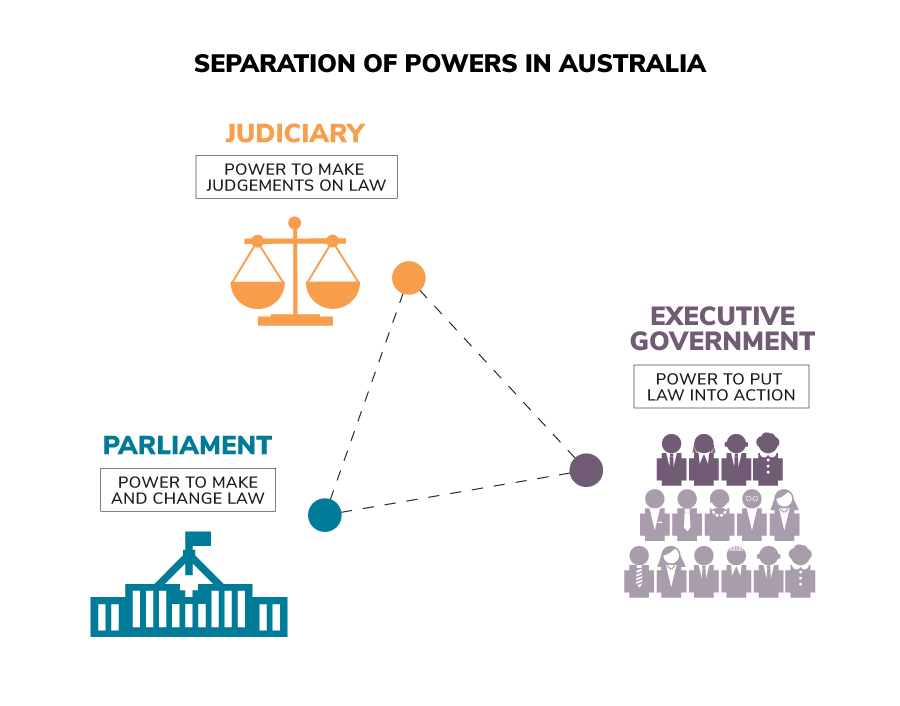In our last Parliament Explained article we wrote about our system of government, how government is formed and what the responsibilities of government include. This article will dive deeper into what a responsible government is, the levels of government, the separation of powers and more.
What do people mean when they refer to ‘responsible government’?
To remain in government, a party or coalition must maintain the support of the majority of members in the House of Representatives. This is part of the principle of responsible government. It ensures the government is accountable to Parliament.
The opposition is the largest party or coalition of parties who did not form government. The opposition is sometimes called the ‘alternative government’ and has a range of responsibilities in the Parliament, including closely examining the work of the government.
The responsibilities of the opposition
The responsibilities of the opposition include:
- scrutinising – closely examining – the work of the government.
- asking the government to explain its actions.
- debating bills – proposed laws – in the Parliament.
- working on committees that examine bills and important national issues.
- providing alternatives to government policies.
Australia has three levels of government that work together to provide us with the services we need.
Levels of government
Each level of government provides different services to Australians:
- Federal parliament: post, telephones and the internet, immigration and defence.
- State and territory parliaments: police, public transport and hospitals.
- Local councils: rubbish collection and recycling, parks, sports fields and swimming pools, and pet control.
If the federal Parliament and a state parliament make conflicting laws about the same thing (for example, education, health, taxation), the Australian Constitution says the federal law overrides the state law.
Read more on the levels of government and watch an explainer video on the PEO website.
Separation of powers
The power to make and manage Australian law is divided between three groups. This division is based on the principle of the separation of powers.
Under this principle, the power to govern is distributed between the Parliament, the Executive and the Judiciary to avoid any group having all the power.
The Parliament is made up of the Queen (represented by the Governor-General), the Senate and the House of Representatives.
The Executive is made up of the Queen (represented by the Governor-General), Prime Minister and ministers.
The Judiciary is made up of the High Court of Australia and other federal courts.
Australia does not have a complete separation of powers; the Executive are members of the Parliament and High Court judges are appointed by the Governor-General.

Image: The separation of powers in Australia. Courtesy of the Parliamentary Education Office.
What makes up the Australian Government?
The Australian Government is formed by the party (or coalition of parties) with the support of the majority of members in the House of Representatives. Although government is formed in the House of Representatives, both the government and opposition also have party members elected to the Senate.
The government manages important national issues like trade, immigration and the environment. Laws passed by the Parliament are put into action by the government. The government also represents Australia internationally.
Who is the executive government?
The Prime Minister and ministers – also called ‘the ministry’ – who lead and manage government departments, are responsible for putting into action government policy and the laws made by the Parliament.
Ministers are members of the Australian Government who have been given an area of responsibility – also known as a ‘portfolio’. Some examples of ministerial portfolios are health, environment, finance, education defence, foreign affairs, trade, community welfare and immigration.
There is a full list of the current Ministry available on the Department of the Prime Minister and Cabinet website.
Want more information?
The Parliamentary Education Office develop and maintain resources to educate Australians about, and inspire their enthusiasm for Australia’s parliamentary democracy. Check out their resources on their website.
Parliament Explained series
Across the next six months, the About the House team is exploring the topics such as: democracy, federation, government and parliament.
Follow our series on our Facebook Page.